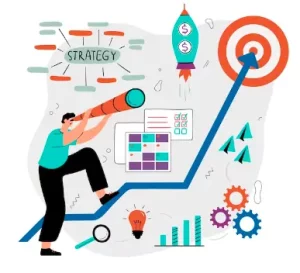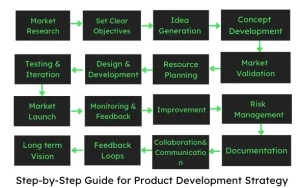Guide to Product Development Strategy
Product development is bringing a new product to the market. The development starts from defining concept to seeking market response, and from creating a prototype to building the product. After the product development, creating sales campaign to make the customers aware is a part of product development strategy.

Let us now dive into understanding the strategy of product development in detail.
What is product development strategy?
Formulating a product strategy delineates the methodology, objectives, and procedures involved in producing and improving goods and services.
Research, design, prototyping, testing, and implementation are all included to coordinate innovation with organisational goals and market demands. This approach directs a product’s whole lifecycle, from conception to launch, promoting competitiveness and long-term growth in the dynamic business environment.
How to develop a product strategy?
Developing a product development strategy involves a comprehensive approach that aligns innovation with market demands and business goals.
Here’s a step-by-step guide:

- Market Research:
Identify target markets, customer segments, and their needs. It is good to start with a market research because that sets the aim correctly. You should analyse what your competitors are into to understand market trends and gaps. - Set Clear Objectives:
It is important to understand what is the purpose of developing the product. It is better to define specific goals for the product, like target audience, what will be the development cost, user engagement, market share, etc. - Idea Generation:
Brainstorm ideas internally or involve cross-functional teams. Prioritise ideas based on alignment with objectives and feasibility. - Concept Development:
Define the core features and value proposition of the product. Create mockups, sketches, or prototypes to visualise the concept. - Market Validation:
Identifying whether the market will accept the product or not is also important. Conduct surveys, interviews, or focus groups to gather feedback from potential users. Validate the product concept’s fit with the target audience. - Resource Planning:
Assess the required resources, budget, and timeline for development. Allocate responsibilities to team members and stakeholders. - Design and Development:
Create detailed designs, wireframes, and specifications. Develop the product using agile or lean methodologies. - Testing and Iteration:
Conduct thorough quality assurance and user testing. Collect feedback and make iterative improvements. - Market Launch:
Develop a marketing plan to create awareness and generate interest. Prepare sales and support teams for customer inquiries. - Monitoring and Feedback:
Monitor key performance indicators (KPIs) to assess the efficacy of the product. Get input from users to determine what needs to be improved. - Continuous Improvement:
Regularly update the product based on user feedback and emerging trends. Adapt to changes in the market and technology landscape. - Risk Management:
Identify potential risks and develop mitigation strategies. Have contingency plans in place for unexpected challenges. - Documentation:
Maintain comprehensive documentation of the product’s features, design, and development process. Document lessons learned for future reference. - Collaboration and Communication:
Foster open communication among cross-functional teams. Ensure stakeholders are aligned and informed throughout the process. - Feedback Loops:
Incorporate feedback from customers, stakeholders, and team members into the strategy. Adapt the system based on evolving insights. - Long-Term Vision:
Consider the product’s lifecycle and plan for future updates, enhancements, or potential pivots.
Also Read : How to Develop a Progressive Web App?
Tools and Techniques of product development
Here’s a detailed exploration of the tools and techniques commonly used in digital asset product development:
- Idea Generation and Conceptualisation:
- Brainstorming sessions are group brainstorming sessions used to produce and hone ideas for digital assets.
- Mind mapping is a visual method for organising and investigating different ideas and connections.
- Storyboarding is planning the flow of interactive assets by creating visual narratives or sequences.
- Design and Creation:
- Software for graphic design: Programs for producing visual elements, such as Adobe Photoshop, Illustrator, or Canva.
- 3D modeling software: programs for producing three-dimensional objects, such as Autodesk Maya or Blender.
- Animation software: Programs for making motion graphics and animations, such as Adobe After Effects or Unity.
- Prototyping and Mockups:
- Prototyping Tools: To create interactive prototypes, use programs like Figma, Adobe XD, or Sketch.
- ZapWorks and other similar tools are useful for prototyping augmented reality (AR) experiences that are interactive.
- Coding and Development:
- Coding languages for web-based digital assets that provide functionality and interactivity include HTML, CSS, and JavaScript.
- Unity: For creating 3D games, simulations, and interactive assets.
- AR/VR Development: Software for building immersive experiences, such as Unreal Engine or Unity.
- User-Centred Design:
- Persona Development: Creating user personas to understand the target audience’s needs and preferences.
- User Testing: Gathering feedback from users to improve the usability and effectiveness of digital assets.
- Quality Assurance and Testing:
- Cross-Browser Testing: Using programs such as BrowserStack to test for compatibility between various browser versions.
- Usability testing is the process of identifying usability problems by watching users interact with digital assets.
- Version Control and Collaboration:
- Git: Track changes, collaborate with team members, and manage different versions of digital assets.
- Collaboration Tools: Platforms like Microsoft Teams, Slack, or Trello for efficient communication.
- Digital Asset Management:
- Digital Asset Management (DAM) Software: Tools like Bynder or Widen for organising, storing, and sharing digital assets.
- Security and Licensing:
- Digital Rights Management (DRM): Protecting intellectual property by controlling access to digital assets.
- Licensing Platforms: Services like Getty Images or Shutterstock for licensing and selling digital assets.
- Deployment and Distribution:
- Website Hosting: For web-based assets, use platforms like AWS or GitHub Pages for hosting.
- Content Delivery Networks (CDNs): Speed up asset delivery with CDNs like Cloudflare or Akamai.
- Monetization Strategies:
- E-commerce platforms: Websites that allow you to sell digital goods, such as Shopify or WooCommerce.
- Subscription models: Providing digital content via services that require a subscription.
- Feedback and Iteration:
- User Input and Analytics: Gather input from users and examine usage patterns to improve digital resources.
- A/B testing: Test various iterations of digital assets to maximise results and engagement.
- AR and VR Development:
- ARKit (iOS) and AR Core (Android) are AR development kits that allow you to create augmented reality experiences.
- VR Development: The process of creating immersive virtual reality experiences using programs like Unreal Engine or Unity.
- Emerging Technologies:
- Blockchain: Utilise blockchain technology for secure ownership verification and traceability of digital assets.
- AI and Machine Learning: Incorporate AI for generating dynamic or personalised digital assets.
Conclusion
By identifying market trends, understanding user needs, and strategizing for competition, businesses can pave the way for impactful product journeys.
For personalised guidance and assistance in shaping your product strategy, contact us at hello[at]noboruworld.com. Let’s collaborate to transform your ideas into tangible, market-leading solutions that stand the test of time.
FAQ’s
What is a product development strategy?
A product development strategy describes the methods, objectives, and procedures for developing, improving, or changing products in order to satisfy consumer needs and achieve corporate goals.
How do I identify the right target market for my product?
Do in-depth market research to comprehend consumer needs, preferences, and segments. Examine demographics, habits, and issues to determine who your target market is.
What role does competition play in product strategy?
Finding market trends, identifying gaps, and honing your product’s distinct value proposition are all made easier by researching your competitors. It effectively positions your development and directs differentiation.
What are the key components of a successful product development strategy?
Market research, idea generation, validation, prototyping, resource planning, risk management, and ongoing adjustment to shifting market conditions are all components of a winning strategy.



